BME Research Areas
To allow the student to concentrate in a specific area of biomedical engineering, we have partitioned the research programs of each of the faculty into generalized areas, representing pathways for the students to pursue. Importantly, the interdisciplinary nature of biomedical engineering means that these pathways are only meant to "guide" the student and in reality, it is up to the student to determine the nature of their research. Tying together molecular biomedical engineering with instrumentation may create a new biosensor based diagnostic or integrating biomechanics with biomaterials will ensure that structurally appropriate materials are used as tissue substitutes.
Again, the pathways are intended to help the student focus on a specific research area, but are, in no way, meant to constrain the interdisciplinary nature of the work. Indeed, the students are encouraged to "think outside the box," in terms of understanding the nature of human disease and developing new diagnostics, therapeutics or medical devices.
- Biomaterials and Biomechanics
- Bioimaging/Molecular Imaging
- Tissue Engineering/Regenerative Medicine
- Bionanotechnology
- Molecular Biomedical Engineering
- Medical Instrumentation
- Biomedical Modeling
Biomaterials and Biomechanics
Biomaterials
Biom aterial combines both material sciences and biomedical aspects. A biomaterial replaces
a part or a function of the body in a safe, reliable, economic and physiologically
acceptable manner. A variety of devices and materials are used in the treatment of
disease or injury. Common examples include sutures, needles, catheters, plates, implants,
artificial skin, implantable devices and tooth fillings. A biomaterial is a synthetic
material used to replace part of a living system or to function in intimate contact
with living tissue. A biomaterial deals with the design, synthesis and applications
of both living and non-living materials for temporary and permanent replacement of
human tissues.
aterial combines both material sciences and biomedical aspects. A biomaterial replaces
a part or a function of the body in a safe, reliable, economic and physiologically
acceptable manner. A variety of devices and materials are used in the treatment of
disease or injury. Common examples include sutures, needles, catheters, plates, implants,
artificial skin, implantable devices and tooth fillings. A biomaterial is a synthetic
material used to replace part of a living system or to function in intimate contact
with living tissue. A biomaterial deals with the design, synthesis and applications
of both living and non-living materials for temporary and permanent replacement of
human tissues.
Biomechanics
Biomechanics implements broad knowledge of mechanical and civil engineering in solving
biomedical problems. Biomechanics has a long history and has built a foundation for
modern biomedical engineering. Mechanics is the engineering science that deals with
studying, defining, and mathematically quantifying "interactions" that take place
among "things" in our universe. Our ability to perceive the physical manifestation
of such interactions is embedded in the concept of a force and the "things" that transmit
forces among themselves are classified for purposed or analysis as being solid, fluid
or some combination of the two. What alters mechanics into the field of biomechanics
is the fact that biomechanics is the science that deals with the time and space response
characteristics of biologic solids, fluids and viscoelastic materials to imposed systems
of internal and external forces. The principles of biomechanics have been applied
and used for monitoring physiologic function, processing the data thus accumulated,
theories to explain the data, diagnosing why the human "engine" malfunctions as a
result of disease, aging and ordinary wear, repairing and rehabilitating body parts
and supporting ailing physiologic organs.
Bioimaging/Molecular Imaging
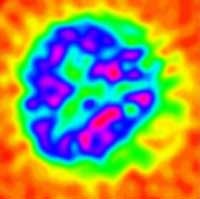 The field of Bio-imaging has experienced phenomenal growth within the last century.
Whereas imaging was the prerogative of the defense and the space science communities
in the past, with the advent of powerful, less-expensive computers, new and expanded
imaging systems have found their way into the medical field. Systems range from those
devoted to planar imaging using x-rays to technologies that are just emerging, such
as virtual reality. Hardware design and software algorithm development for a wide
array of imaging technologies applicable to medicine, including MRI, fMRI, PET and
CT.
The field of Bio-imaging has experienced phenomenal growth within the last century.
Whereas imaging was the prerogative of the defense and the space science communities
in the past, with the advent of powerful, less-expensive computers, new and expanded
imaging systems have found their way into the medical field. Systems range from those
devoted to planar imaging using x-rays to technologies that are just emerging, such
as virtual reality. Hardware design and software algorithm development for a wide
array of imaging technologies applicable to medicine, including MRI, fMRI, PET and
CT.
Tissue Engineering/Regenerative Medicine
Tissue engineering is an emerging interdisciplinary field which applies the principles of biology and engineering to the development of viable substitutes which restore, maintain, or improve the function of human tissues. This form of therapy differs from standard drug therapy in that the engineered tissue becomes integrated within the patient, affording a potentially permanent and specific cure of the disease state.
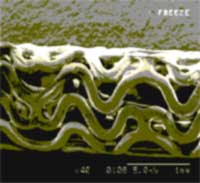 A large number of Americans suffer organ and tissue loss every year from accidents,
birth defects, hereditary disorders, conditions and diseases. Improved understanding
of biological processes holds promise for the development of new classes of biomaterials,
polymers diagnostic and analytical reagents.
A large number of Americans suffer organ and tissue loss every year from accidents,
birth defects, hereditary disorders, conditions and diseases. Improved understanding
of biological processes holds promise for the development of new classes of biomaterials,
polymers diagnostic and analytical reagents.
Tissue engineering integrates discoveries from biochemistry, cell and molecular biology, genetics, material science and biomedical engineering to produce innovative three dimensional composites having structure/function properties that can be used to either replace or correct damaged, missing or poorly functioning components in living systems. In addition, this emerging technology can be used to introduce better functioning components. The material components themselves may be processed from naturally occurring materials, processed from synthetic materials or a combination of these. Cellular and other biologic components may be added.
Tissue engineering faces the challenges in:
- Permanent versus biodegradable
- Optimal lifespan of scaffold or product
- Degradation products
- Biocompatibility
- Optimal geometry/architecture/composition
- Surface features (and how to modify them e.g., biomimetics)
- Role of surface features in biointegration
- Biomechanical characteristics
- Reproducibility
Bionanotechnology
Bionanotechnology holds exciting opportunities to bring high-impact advances in the field of bioengineering and medicine. Exquisite biological nanostructures are a natural means by which cells interact with one another and with the extracellular matrix. Bionanotechnology offers at the nanoscale (100,000 times smaller than the diameter of the average human hair) the ability to provide insight into the structural features of biological systems such as cell or tissue as well as to develop nanobiomaterials/medical devices for diagnostics, therapeutics and tissue regeneration. Ongoing work includes development nanoprobes that can characterize the nanoscale structure and function of cells; design of multi-functional nanobiosystems for therapeutics, localized therapy delivery and for functional tissue repair/regeneration; innovative techniques for chromosome sorting; development of technologies to characterize the physio-chemical, structural and biological properties of nanostructured assemblies/materials; design of artificial biomaterials through molecular synthesis and nanoscale self-assembly.
Molecular Biomedical Engineering
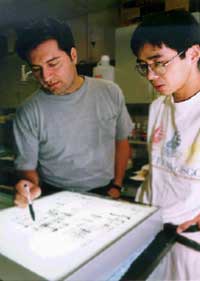 Analysis and manipulation of the genome and development of processes for applying
this knowledge in the clinic. Emphasis is on the discovery of novel genes active in
tissue healing and adaptation as well as the development of therapeutic drugs, antibodies,
vaccines, proteins and antisense products for agricultural, environmental and medical
applications. Current work is being conducted on the progression of cardiovascular
diseases, diseases of the musculoskeletal system. New technolgies, such as CRISPR,
are being used for various applications.
Analysis and manipulation of the genome and development of processes for applying
this knowledge in the clinic. Emphasis is on the discovery of novel genes active in
tissue healing and adaptation as well as the development of therapeutic drugs, antibodies,
vaccines, proteins and antisense products for agricultural, environmental and medical
applications. Current work is being conducted on the progression of cardiovascular
diseases, diseases of the musculoskeletal system. New technolgies, such as CRISPR,
are being used for various applications.
Medical Instrumentation
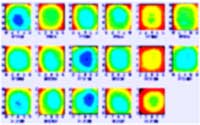 Today's medical instruments are considerably more complicated and diverse, primarily
because they incorporate electronic systems for sensing, transducing, manipulating,
storing and displaying data or information. Medical diagnostic today more and more
relies on detailed and accurate measurements of a vast number of physiologic parameters
for diagnosing illnesses and prescribe complicated procedures for treating these.
While medical instruments acquire and process information and data for monitoring
patients and diagnosing illnesses, medical devices use electrical, mechanical, chemical
or radiation energy for achieving a desired therapeutic purpose, maintaining physiologic
functions or assisting a patient's healing process.
Today's medical instruments are considerably more complicated and diverse, primarily
because they incorporate electronic systems for sensing, transducing, manipulating,
storing and displaying data or information. Medical diagnostic today more and more
relies on detailed and accurate measurements of a vast number of physiologic parameters
for diagnosing illnesses and prescribe complicated procedures for treating these.
While medical instruments acquire and process information and data for monitoring
patients and diagnosing illnesses, medical devices use electrical, mechanical, chemical
or radiation energy for achieving a desired therapeutic purpose, maintaining physiologic
functions or assisting a patient's healing process.
Development of novel clinical diagnostic, therapeutic and prosthetic devices based on advances in physiology research, materials, electronics and computational capabilities. Ongoing work includes use of vibromyography for diagnosis of osteoporosis, neural networks applied to heart auscultation, rapid sequencing of the human genome, self assembled materials, surface coatings to enhance tissue ingrowth and ultrasonic measurements of bone quality. The research topics include: Ultrasound - Diagnostic, Treatment, Biosensors.
Biomedical Modeling
Biomedical Modeling
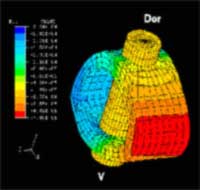 Biomedical modeling imploys the use of computer simulations, discrete mathematics
and numerical methods in order to mimic dynamic biomedical systems. Among other purposes
simulations and models are often used in order to support and strengthen experimental
conclusions as well as to provide a more accurate model of behavior in tough to image
systems. Here at Stony Brook, advances are made using our own Seawulf Computing Cluster, and the New York Blue Super Computer, currently the fastest super computer available for non-classified research.
Biomedical modeling imploys the use of computer simulations, discrete mathematics
and numerical methods in order to mimic dynamic biomedical systems. Among other purposes
simulations and models are often used in order to support and strengthen experimental
conclusions as well as to provide a more accurate model of behavior in tough to image
systems. Here at Stony Brook, advances are made using our own Seawulf Computing Cluster, and the New York Blue Super Computer, currently the fastest super computer available for non-classified research.
Biomedical Rehabilitation
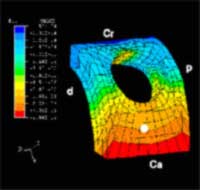 Analysis of human exposures to toxic, carcinogenic or hazardous conditions, and the
potential consequences of these exposures. Product and process designs for reduction
or elimination of conditions associated with workplace and residential injury. Development
of medical devices directed toward intervention in preventable conditions and diseases
(e.g. osteoporosis, bone and muscle atrophy in space, musculo-skeletal disorders in
paraplegia).
Analysis of human exposures to toxic, carcinogenic or hazardous conditions, and the
potential consequences of these exposures. Product and process designs for reduction
or elimination of conditions associated with workplace and residential injury. Development
of medical devices directed toward intervention in preventable conditions and diseases
(e.g. osteoporosis, bone and muscle atrophy in space, musculo-skeletal disorders in
paraplegia).
